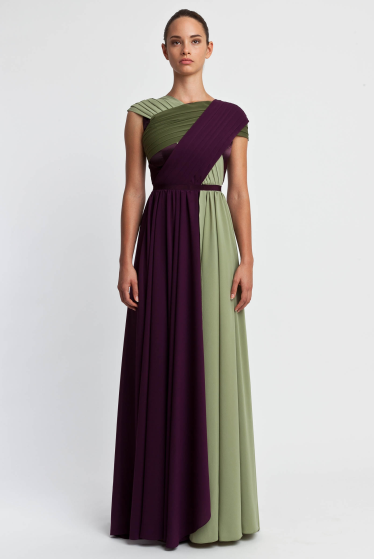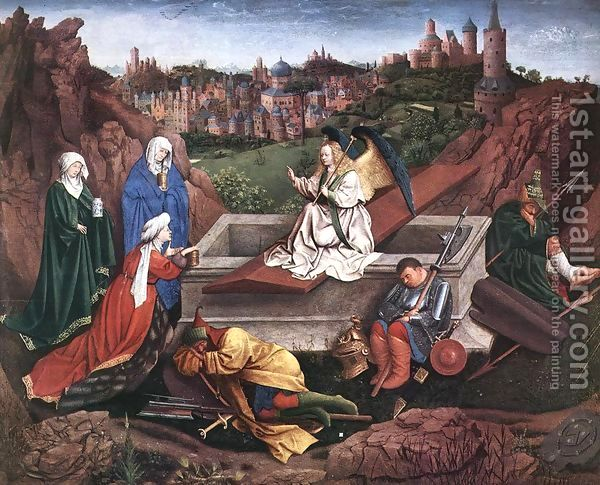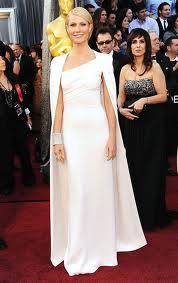- The Roman Dress: Roman Stola for Women
- The Medieval Cloak
- The 16th Century Men’s Dress: Breeches
- The 17th Century Women’s Accessory: The Lace Collar
- List of Pictures
- Justification Statement. The Roman Dress: Roman Stola for Women
- Justification Statement: The Medieval Cloak
- Justification Statement. The 16th Century Men’s Dress: Breeches
- Justification Statement. The 17th Century Women’s Accessory: The Lace Collar
- Works Cited
The Roman Dress: Roman Stola for Women


The Medieval Cloak


The 16th Century Men’s Dress: Breeches


The 17th Century Women’s Accessory: The Lace Collar


List of Pictures
Picture 1. The statue of Livia wearing the Roman Stola (“Introduction to Ancient Rome”).
Picture 2. The model of a contemporary dress by Stephan Pelger (“Stephan Pelger: Long Dress”).
Picture 3. The painting by Hubert van Eyck The Three Marys at the Tomb, the figures depicted are wearing cloaks (“Hubert van Eyck: The Three Marys at the Tomb”).
Picture 4. An actress wearing a dress and a cloak (“Dressing Vogue”).
Picture 5. King Edward VI wearing breeches as the element of dress (“The Costume Manifesto”).
Picture 6. Modern breeches for horsemen (“Horse Stack”).
Picture 7. The portrait of Frances Howard by Marcus Gheeraerts wearing the dress with a lace collar (“Rate the Dress”).
Picture 8. The modern model of a lace collar (“Rialto Lace Collar Finished”).
Justification Statement. The Roman Dress: Roman Stola for Women
The stola is a typical dress for women during the Roman period. The form of the stola as the pleated dress is similar to the form of the contemporary dress with a lot of drapery elements. The Roman stola can be discussed as a traditional ankle-length dress which can be designed with sleeves or without them (Tortora and Eubank).
The contemporary adaptation presented in the picture is the model of a long dress by Stephan Pelger which resembles the stola in the manner to drape the cloth. Today, there are many variants of long dresses for women, but not all of them can be designed as the stola. Thus, the key particular feature of the stola is the usage of much cloth which is virtuously draped and fixed with the help of a fibula. The contemporary variant of the stola is based on the usage of several pieces of fabric to drape them as the pleated dress.
It is important to note that only noble women and women with a good social reputation could wear the stola during the Roman period. There were two variants of garments which could be worn over the tunic. They were the stola and toga. The stola was worn by women, and togas were worn by men.
However, those women who had the notorious reputation or were divorced because of adultery could wear only togas. That is why, it was possible to draw conclusions about the social status of a woman with references to this type of garments. Today, long dresses which have similarities with the stola can be worn by women without references to their social statuses. Nevertheless, this variant of clothing is usually perceived as appropriate for attending the social events.
Justification Statement: The Medieval Cloak
During the Medieval period, different social categories wore various types of cloaks. The differences could be noted with references to the material used for the cloak or with references to the model of a cape. Cloaks could have or not sleeves (Tortora and Eubank).
The figures depicted in the picture are wearing long cloaks without hoods, and their waists are belted. It is possible to discuss the depicted cloak as a woolen one. The contemporary variant of a cloak presented in the picture is long and plain in design. There are no sleeves and hoods. The main similarity of these two variants of a cloak is in the plainness of design.
In spite of the fact the medieval cloaks were worn by different social categories, there were no obvious differences in the design of a cloak. The richness of a person in a cloak could be determined paying attention to the material of a brooch used to fix the cloak. Thus, the medieval cloaks were worn by both men and women from all the social classes as the elements of the outerwear.
They were traditionally made from woolen material. The representatives of nobility wore velvet cloak of deep green and blue colors decorated with brooches when the members of the lower classes wore dark woolen cloaks with hoods which were the main outerwear to save from the cool wind.
The differences in material used for manufacturing cloaks could help in distinguishing between the representatives of different classes. Today, cloaks are worn as the elements of the everyday garment in spite of the social status of a person, and they are typically with hoods and sleeves.
Justification Statement. The 16th Century Men’s Dress: Breeches
Breeches are one of the main elements of the men’s garment in the 16th century. Breeches were not typically long, and they ended above or below the knee. King Edward VI is depicted on the portrait in Christ’s Hospital Horsham in rather short breeches which end above the knees.
Breeches worn in the 16th century were different not only in length but also in form, material, and decoration. Thus, too loose breeches were tied with the help of bands to create the particular form. Leg bands were narrow and could be decorated with the help lace. The modern variant of breeches which is presented in the next picture differs significantly from the breeches of the 16th century in form, but the length is similar.
From this point, the main characteristic feature of breeches which is repeated in the modern models is the length which can be above of below the knee.
During the 16th century, only several categories of the European population could afford to wear garments from velvet or silk and decorated with lace (Tortora and Eubank). That is why, the material from which breeches were made could help determine the social status of a man. It is important to note that breeches were worn only by the representatives of the upper and middle classes.
The usual material for breeches was flannel. Thus, breeches from flannel were typical for the middle-class men when noble men and aristocracy could afford to wear silken breeches decorating with lace. Today, breeches are worn by military men or horsemen because of their appropriateness for riding. Modern breeches can be discussed as the clothing worn by nobility or upper-class men when they are elements of the costume for riding, but not the working clothes.
Justification Statement. The 17th Century Women’s Accessory: The Lace Collar
The particular feature of the women’s dress during the 17th century is the collar. However, men also wore lace collars during the 16th -17th centuries. It is necessary to note that lace collars were the elements of the aristocracy’s garment.
Lace collars were often large and wide to accentuate the richness and significance of a person who wears it (Tortora and Eubank). Male lace collars were traditionally not very large, and they were rather low. Lace collars for women were different in forms, and they were rather high if the woman belonged to the aristocratic family. Nevertheless, during the 17th century, women also wore wide lace collars round the low collar of the dress.
That is why, the tradition to wear lace collars round the neck or round the dress’s collar is also typical for the 17th century, and it is reflected in the picture depicting the modern variant of the lace collar. Frances Howard is portrayed by Marcus Gheeraerts wearing the delicate lace collar. The idea to wear it as the independent element of the garment is reflected in the modern variant of the collar.
During the 17th century, collars were made from lace that is why the element of the garment was worn only by rich persons. Moreover, large and wide lace collars could provide the information about the person’s aristocratic origins. Today, collars can be made not only from lace but also from any other material to decorate the dress.
Furthermore, there are no modern lace collars for men which can be worn in the everyday life. Modern models of collars can be also knitted to imitate the lace. It is impossible to discuss the status of a person today with references to the collars worn.
Works Cited
Dressing Vogue. 2012. Web.
Horse Stack. 2013. Web.
Hubert van Eyck: The Three Marys at the Tomb. 2011. Web.
Introduction to Ancient Rome. 2012. Web.
Rate the Dress. 2013. Web.
Rialto Lace Collar Finished. 2012. Web.
Stephan Pelger: Long Dress. 2012. Web.
The Costume Manifesto. 2011. Web.
Tortora, Phyllis, and Keith Eubank. Survey of Historic Costume: A History of Western Dress. USA: Fairchild Publications, 1998. Print.